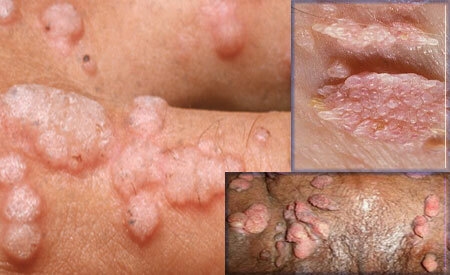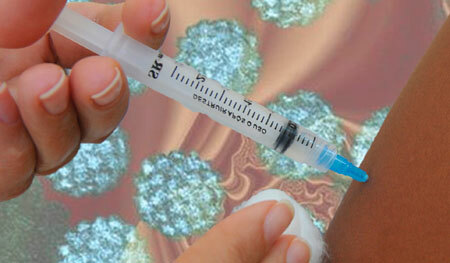What is it?
Human papillomavirus( HPV, Human papillomavirus) today is detected in at least one third of women. It is a DNA virus that provokes uncontrolled cell division. Infection can lead to the appearance of unaesthetic outgrowths on the skin - papillomas, warts and condylomas.
People usually get infected with the virus at a young age, at the peak of their sexual activity and later reap the fruits of their not always considered actions. After infection of women with human papillomavirus 16 and 18 types is fraught with the development of cancer. But do not panic, type 18 in women is not a sentence, the treatment exists, how to live and what to do with the virus, we will consider in detail below, as not all uniquely and universal "pill" does not exist yet.
In addition, a number of studies have been conducted in recent years, the results of which suggest that an increase in the incidence of laryngeal and respiratory papillomatosis in children may be due to their infection with HPV at birth naturally from an infected mother.
HPV 16, 18 in women what is it?- this is a kind of human papilloma virus, abbreviated HPV.There are a lot of virus species and for convenience they were simply numbered, because not all of them are dangerous for humans.16 and 18 type are among the most dangerous, for more details see the special section below.
Contents of
- 1 Causes of HPV in women
- 2 Symptoms of human papillomavirus in women
- 3 Diagnosis of papilloma virus in women
- 4 Treatment of human papillomavirus in women
- 4.1 Methods for removing papillomas
- 4.2 Papillomavirus during pregnancy, what should I do?
- 4.3 Treatment of HPV with folk remedies
- 5 Human papillomavirus in women 16 and 18 of type
Causes of HPV in women
 The causes of papillomatosis are quite commonplace. The main ways of transmission of HPV is contact-household and sexual. Although it is also possible to get infected with various medical examinations, if the rules of antiseptics have not been observed.
The causes of papillomatosis are quite commonplace. The main ways of transmission of HPV is contact-household and sexual. Although it is also possible to get infected with various medical examinations, if the rules of antiseptics have not been observed.
Thus, you can grab a dangerous virus without even leading a disorderly sex life, but only by visiting a public place, since it can penetrate the body even through tiny cracks in the skin that are invisible to the naked eye, but are present at all.
Fortunately, in most cases, the immune system immediately copes with viruses that have entered the body, so the disease often develops in people with weakened immunity.
Even if a HPV infection has occurred, signs of it do not appear immediately. While the woman is healthy and her immune system is working normally, she may not even know about the presence of infection. The causes of the symptoms of human papillomavirus in women are as follows:
- hypothermia;
- transfer of various diseases, mainly of a viral nature, for example, ARVI;
- hormonal disorders, including pregnancy;
- installation of an intrauterine device;
- abortion;
- immunosuppressive( immunosuppressive) therapy, etc.
Symptoms of human papillomavirus in women

As a rule, the first signs of pathology appear 3-4 months after infection. Infection with HPV is manifested by the appearance of so-called papillomas.
Most often they are located on the body parts with thin, sensitive skin, for example, on the face, eyes, mucous membranes of the mouth and nose, in the axilla, neck, crotch, genitals, rarely on the back. These neoplasms usually represent outgrowths on a small pedicle initially small in size, but with further weakening of immunity and non-interference they begin to grow and spread, and eventually can merge into large conglomerates.
Papillomas can be either single or multiple, and also have different sizes. Often the coloration of neoplasms does not differ from the tone of healthy skin, although it is possible to form outgrowths of darker or light shades.
If the papillomas are located in the genital area and have a sharp shape, they are called genital warts. As a rule, condylomas are found not only on the skin of the perineum, but also on:
- inner walls of the vagina;
- in the throat of the urethra;
- vulva;
- perianal area;
- the cervix.
If the disease affects the genitals and urethra, there may be signs of a papilloma virus, such as:
- itching;
- soreness with urination;
- discomfort during sexual intercourse;
- minor bleeding during or after intercourse.
In addition to genital warts,
- papillary varieties can also be formed;
- giant condyloma of Buschke-Lowenstein;
- intraepithelial;
- are flat.
Diagnosis of papilloma virus in women
Modern scientists have identified 27 species from 5 genera and more than 170 types of HPV, but only some of them can cause diseases of the urogenital tract.
The types of the virus differ by the degree of oncogenic risk. So, it is distinguished( by types):
- Low risk - HPV 3, 6, 11, 13, 32, 34, 40, 41, 42, 43, 44, 51, 61, 72, 73;
- Medium risk - HPV 30, 35, 45, 52, 53, 56, 58;
- High-risk HPV 16, 18, 31, 33, 39, 50, 59, 64, 68, 70.
In the early stages, it is difficult to visually diagnose papillomatosis, since the neoplasms represent only small roughness with dotted vessels. A characteristic capillary network on them is formed much later.
If the traces of human papilloma virus infection in women are on the cervix, colposcopy is performed. The essence of the method consists in the study of tissues with the help of a special apparatus capable of giving a multiple increase. For diagnostic purposes, the gynecologist can conduct painless tests with ethanic acid and Lugol's solution.
One of the main methods of diagnosing human papillomavirus in women is a cytological examination of smears. Indicates the presence of HPV presence in the material taken of specific cells - koylocytes. Also, this analysis can detect only beginning cervical cancer, when there is still no visual change in the tissues.
The most progressive method of detecting HPV is the Digene test. It is based on complex biochemical reactions, due to which the test is characterized by the highest sensitivity. As a material for the study may be a scraping of epithelial cells or a sample obtained by biopsy.
Other methods, for example, PCR, are rarely used, mostly only in the asymptomatic form of the pathology pathway and to determine the variety of the virus.
Because HPV infection occurs mainly during sexual intercourse, it is recommended that women who have been diagnosed have a full examination and tests for other STDs.
Treatment of human papillomavirus in women

If any neoplasms are found, you should immediately consult a doctor to find out their nature and origin. Women who have HPV, especially type 16 or 18, need treatment to prevent cancer.
Although it should immediately be noted that it is not yet possible to completely cure the papilloma virus. Therefore, the main goals of therapy is to remove papillomas and strengthen immunity - drive the virus into a "dormant" state, stop development in the body and the emergence of new papillomas. .
With the implementation of the second task, everything is relatively clear. In order to strengthen immunity in the treatment of HPV patients, in general, prescribe vitamins and immunostimulants. Most often this is due to the fact that it is easier for people to drink ready-made tablets than to strengthen immunity in other ways. The full recommended list is as follows:
- vitamins;
- immunostimulants;
- healthy eating;
- active way of life;
- regular walking tours;
- hardening, etc.
In this case, women are recommended to take antiviral drugs to suppress the activity of HPV.As for the removal of existing neoplasms, this can be done by various methods, depending on the patient's capabilities, the clinic and the diagnostic indications.
Methods for the removal of papillomas
1. Laser therapy. This method is one of the most effective and safe. Papilloma is removed under local anesthesia for 1 procedure without bleeding, as small vessels are immediately "sealed".If properly carried out after the manipulation, a crust remains on the site of growth of the formation, after disappearance of which there is practically no trace of any trace on the skin. Can be used to treat human papillomavirus in pregnant women.
2. Radio-frequency therapy .The method appeared in the arsenal of dermatologists much later than others and is considered one of the safest and most promising. Its essence consists in cutting new growths with a special radio-wave knife. After manipulation on the skin, there are no visible traces.
3. Surgical intervention. The method is considered the most affordable, but its use is fraught with the formation of scars on the skin. Removal of papilloma is performed by a surgeon manually using a scalpel after preliminary anesthetizing the area around it. Nevertheless, surgical intervention or radio wave therapy is preferable to choose if there is a suspicion of malignancy( the formation of cancer cells) of the neoplasm, as when they are used pathological tissues are not destroyed and can be sent for histological examination.
4. Electrocoagulation. The method involves the removal of neoplasms due to the thermal effect of electric current under local anesthesia. After the procedure, the crust remains in place of the papilloma, and after it falls off, a slight scar may remain on the skin.
5. Removal by chemical means. This method is one of the oldest. It is based on the destruction of the tissues of tumors by aggressive compounds. They are applied to the growth for a certain time several times. The frequency of use and the duration of the application depend on which drug is selected and the amount of papilloma. As a rule, podophyllinum, 5-fluorouracil, podophyllotoxin, trichloroacetic acid, Solcoderm are used.
6. Cryotherapy. The essence of the method consists in the destruction of neoplasms with liquid nitrogen, and if almost all other methods require local anesthesia, then this is absolutely painless. But to remove some papillomas may require more than 1 procedure.
Thus, how to treat human papillomavirus in women depends on the size and number of tumors, the state of the patient's immunity, the presence of certain diseases or pregnancy.
In this case, some types of neoplasms can disappear on their own, therefore it is only necessary to consult the doctor after choosing the method of removal by papillomas. But especially hope for spontaneous recovery is not worth it, since it is possible only with an ideal state of the immune system, than today can boast of a few.
The papilloma virus during pregnancy, what should I do?
Special attention should be paid to the treatment of HPV in pregnant women, because if they have or have a condyloma on the genitals on the background of pregnancy, there is a high risk of contracting HPV in childbirth.
In such cases, it is usually recommended after 28 weeks to take drugs that strengthen immunity and suppress viral activity, and try to remove tumors with a laser or cryodestruction method. Also, in order to prevent infection of the fetus during labor, pregnant women may be recommended delivery by caesarean section.
Since it is not yet possible to cure HPV completely, with a decrease in immunity, a relapse of the disease and the symptoms of the human papilloma virus in women may appear again. To prevent this from happening, women are advised to lead an active lifestyle, eat right, avoid stress, regularly visit a gynecologist and take tests for HPV levels in the blood.
Treatment of HPV with folk remedies
Many people try to cope with the folk remedies that have arisen on the skin. This can be unsafe, since a large number of viral particles are concentrated in the papillomas, so if there is an incorrect removal there is a high risk of the appearance of more neoplasms. In addition, damage to the papillomas can provoke uncontrolled multiplication of cells and cause cancer.
Among all folk remedies for the treatment of the papilloma virus in women, we recommend using only those that strengthen the immune system and fight the disease from the inside. It:
- In equal proportions take the root of valerian, melissa and oregano grass, hop cones, coriander fruits, linden flowers, mix and grind.30 grams of the obtained mixture are poured in a thermos bottle in the morning with 0.5 liters of hot water. After 4 hours, the drug begins to take small sips, it must be completely drunk during the day. The course of treatment is 10 days, after a week it is repeated.
- In equal proportions take the rose hips, plantain leaves, nettles, dandelion root and melissa grass, mix and crush.80 g of the obtained mixture are covered in a saucepan and pour 1 liter of boiling water. The broth is cooked on low heat for 15 minutes. After 4 hours it is ready for use. Means take a warm 1 glass before meals 4 times a day. The course of treatment is 7 days, after 10 days it is repeated.
Popular in the people means, celandine, it is worth using with great accuracy, and it is better to abandon it altogether in favor of hardware methods of removing papillomas, because with its accidental ingress on healthy skin areas, severe burns may appear.
Human papillomavirus in women 16 and 18 of the
type The greatest danger to the health and life of women is represented by HPV types 16 and 18.In addition to causing genital warts to form on the genitals, they can provoke dysplasia and cervical cancer. Namely, he is the cause of death of hundreds of thousands of women.
At the same time, human papillomavirus type 31 in women also often causes the development of dysplasia, and with non-interference and cervical cancer, although it is among the viruses with medium oncogenic activity. Therefore, if any type of HPV is detected, it is necessary to consult a gynecologist and undergo a prescribed course of treatment.
But do not panic if a HPV is detected. His presence in the body, even the notorious 16 and 18 types, is not a guarantee of the rapid development of cancer. From the moment of infection to the occurrence of oncology, it can take 10 or 20 years, and timely initiated full-fledged treatment and control over the level of HPV in the future reduces this risk to a minimum.
Because physicians understand the danger of human papillomavirus in women of these types, a vaccine was invented that allows them to protect themselves. But to this day, its effectiveness is controversial.
Thus, HPV is a fairly dangerous virus that can cause cancer. But with timely intervention, its activity can be suppressed and prevented the occurrence of such unfortunate consequences.



